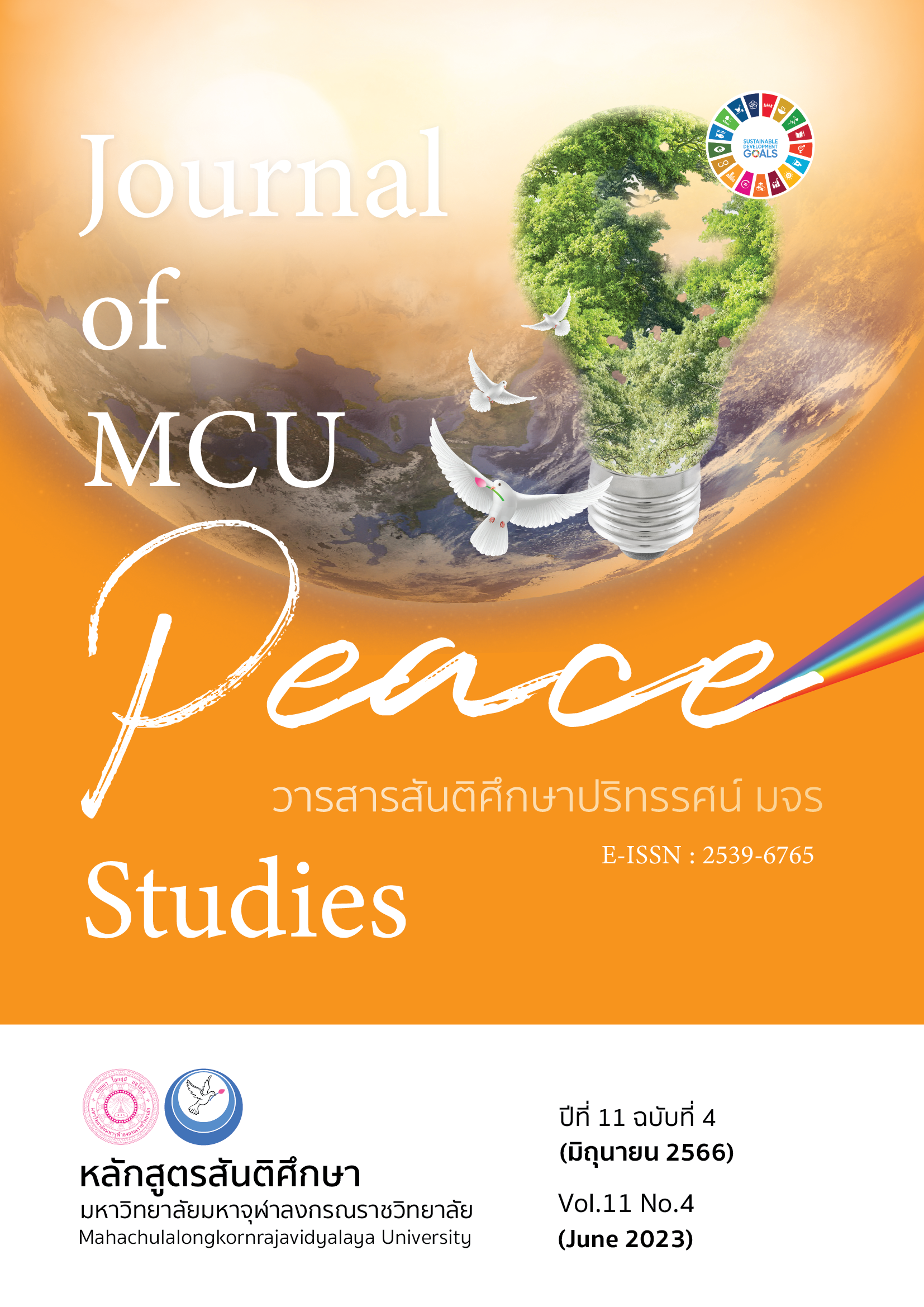Concentration and Absorption in Trilogy Movie Scenes Based on Vidantasa ̅ Sama ̅dhi Curriculum of the Willpower Institute
Main Article Content
บทคัดย่อ
This research article has the following purposes 1) to study concentration and absorption according to the definitions of the Willpower Institute, 2) to study the mise-en-scene in trilogy films based on the concept of concentration and absorption through semiotic film analysis, and 3) to analyze the coherence of trilogy movie elements in the aspect of concentration and absorption. The methodology is a qualitative research study based on basic research, which interpreted the concept of concentration and absorption from the Willpower Institute. However, the study focused on the absorption level, paṭhama-jhāna and the semiotic theory of Ferdinand de Saussure. The analysis of mise-en-scene in the trilogy movies has presented the benefits of concentration and portrayal of absorption state from The Matrix and Kung Fu Panda as a guide for movie study concerning concentration and absorption.
The results of research were as follows: 1. The definition of concentration and absorption from the Willpower Institute has the clear idea that concentration is the cause and absorption is a result, which requires concentration as an essential base. Therefore, concentration is divided into three levels: 1) khaṇika-samādhi, 2) upacāra-samādhi, and 3) appanā-samādhi. Moreover, absorption can be divided into two main characteristics; rūpa-jhāna and arūpa-jhāna. 2. The development of absorption in trilogy movies appears from the main characters, Po and Neo. They gradually show intense levels of absorption, respectively. Po in Kung Fu Panda illustrated that the state of rūpa-jhāna extends to the arūpa-jhāna. In contrast, The Matrix begins by alternating between the arūpa-jhāna and rūpa-jhāna. The step of absorption are more complicated to interpret, which is an exciting presentation of how the meditation process result overlaps with it. 3. Mise-en-scene in the trilogy film study can be classified as 1) awareness mind, 2) delicate mind, 3) mind as one, 4) mind power, and 5) emptiness mind.
Article Details

อนุญาตภายใต้เงื่อนไข Creative Commons Attribution-NonCommercial-NoDerivatives 4.0 International License.
ทัศนะและความคิดเห็นที่ปรากฏในบทความในวารสาร ถือเป็นความรับผิดชอบของผู้เขียนบทความนั้น และไม่ถือเป็นทัศนะและความรับผิดชอบของกองบรรณาธิการ ยินยอมว่าบทความเป็นลิขสิทธิ์ของวารสาร
เอกสารอ้างอิง
American Mindfulness Research Association (2021). Mindfulness Journal Publications by Year, 1980-2020. Retrieved November 10, 2021, from https://goamra.org/Library
AlMuhaiteeb, W. (2021). Heal Yourself with Color. (1st ed.). London: Welbeck Publishing Group.
Boonme, T. (2008). The Revolution Semiotic of Saussure the Road to Postmodernism. (1st ed.). Bangkok: Viphasa.
Boonyaketmala, B. (2009). The Seventh Art: For a Culture of Film Criticism. (3rd ed.). Bangkok: Public Bookery.
Cobb, M., & Nelson, J. Y. (2011). Kung Fu Panda 2. [Motion Picture]. United States: DreamWorks Animation.
Cobb, M., Nelson, J. Y., & Carloni, A. (2016). Kung Fu Panda 3. [Motion Picture]. United States and China: DreamWorks Animation and China Film Group.
Cobb, M., & Stevenson, J., & Osborne, M. (2008). Kung Fu Panda. [Motion Picture]. United States: DreamWorks Animation.
Dienstmann, G. (2018). Practical Meditation: A Simple Step-by-Step Guide. (1st ed.). London: Dorling Kindersley Limited.
Phra Brahmapandit (Prayoon Dhammajitto). (2021). Buddhist Psychology and Modern Science Develop the Human Mind. Retrieved May 3, 2020, from https://www.youtube.com/ watch?v=zJKDp54zkKw
Phrakhrusoponbuddharak (Dhammaraso), Phramaha Duangden Thitañano, & Wattanapradith, K. (2017). An Application of the Seven Sappaya for Developing Meditation Instructor Course 39 Willpower Institute Branch 73 Wat Pra-Ngam, Trang Province. Journal of MCU Peace Studies, 5(2), 259-276.
Phra Brahmagunabhorn (P.A. Payutto). (2016). Dictionary of Buddhism. (34th ed.). Bangkok: Thammasapa Publishing.
Pichayapaiboon, P. (2018). Psychology of Art: The Empirical Aesthetic. Bangkok: Chulalongkhong University.
Silver, J., & The Wachowskis. (1994). The Matrix. [Motion Picture]. United States: Warner Bros. Picture.
Silver, J., & The Wachowskis. (2003). The Matrix Reloaded. [Motion Picture]. United States: Warner Bros. Picture.
Silver, J., & The Wachowskis. (2003). The Matrix Revolutions. [Motion Picture]. United States: Warner Bros. Picture.
Smithikrai, C. (2016). Effectiveness of Teaching with Movies to Promote Positive Characteristics and Behaviors. Procedia-Social and Behavioral Sciences, 217, 522-530.
Somdet Phra Yana Vachirodom, (Luangphor Viriyang Sirintharo). (2020). Meditation Instructor Course Volume 2. (20th ed.) Bangkok: Prachachon Co., Ltd.
Sotanasathien, S. (2020). Communication Theories. Bangkok: Thammasat University.
Stroud, S. R. (2014). Technology and Mythic Narrative: The Matrix as Technological Hero-Quest. Western Journal of Communication, 416-441.
Wikipedia Contributors. (2022). Ferdinand de Saussure. Retrieved February 20, 2022, from https://en.wikipedia.org/wiki/Ferdinand_de_Saussure
Ziegler, D. A. et al. (2019). Closed-loop Digital Meditation Improves Sustained Attention in Young Adults. Nature Human Behavior, 3, 746-757.


